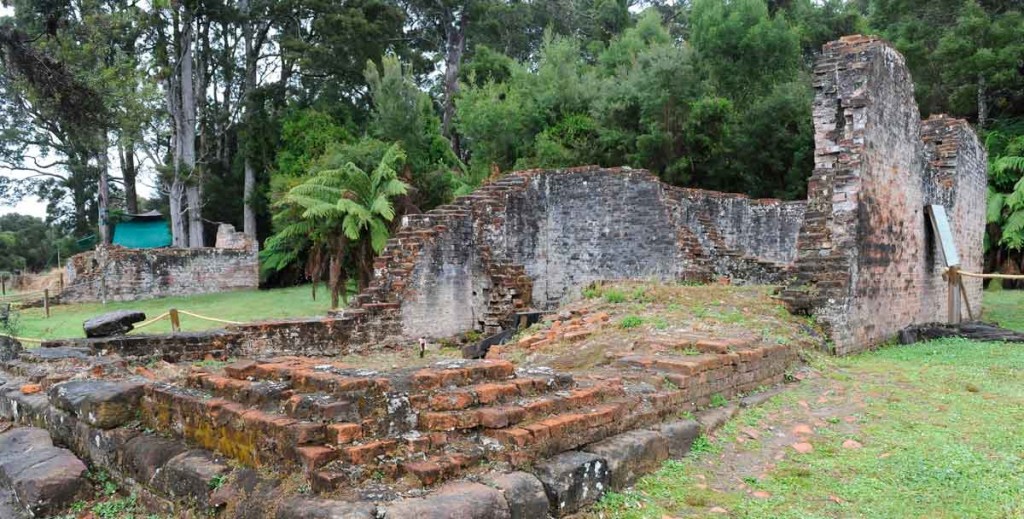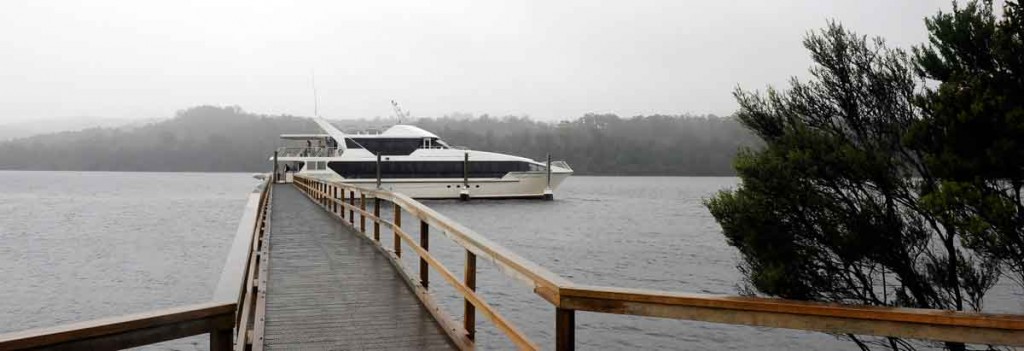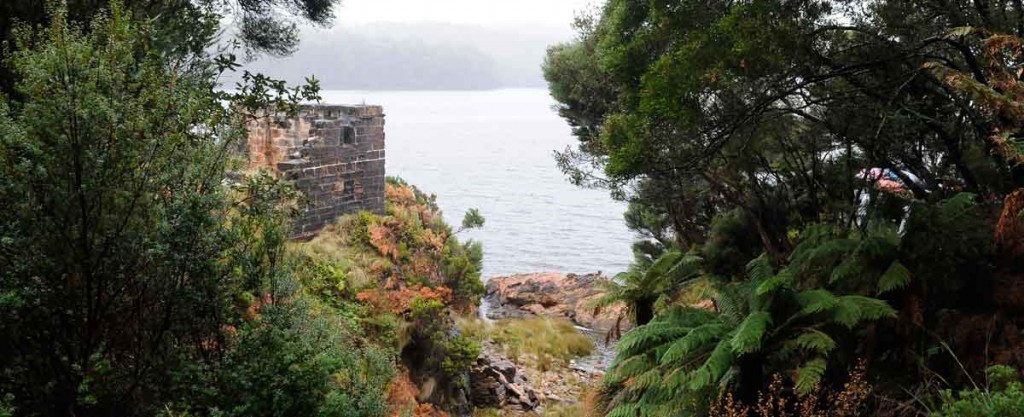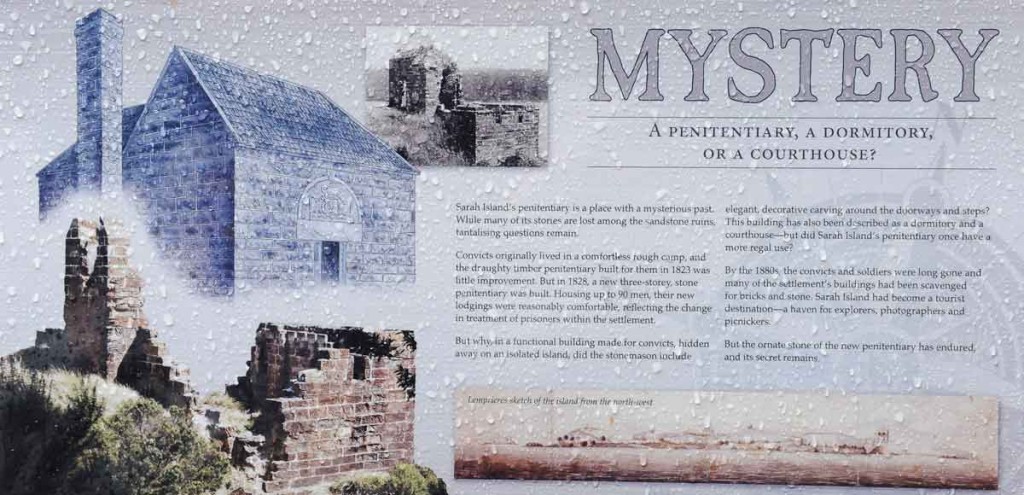
Sarah Island during its ‘notorious’ time.
> Click Here to Visit the Sarah Island Video Clips Page <
When you see the natural beauty of Macquarie Harbour, it’s hard to imagine that back in the 1820s, this was the scene of incredible misery. However, the fact that the entrance to the harbour is known as Hell’s Gates should give you a clue.
Entering the harbour through Hell’s Gates meant navigating waters so treacherous that many lost their lives here. For them it may have been their salvation because what awaited those who did make it was much, much worse than death. Conditions at the penal settlement on Sarah Island in the southern part of the harbour were so harsh that one convict, only known as Trenham, went as far as stabbing a fellow inmate, reasoning that this would get him executed and he wouldn’t have to spend more time in this hell.
Originally, the Macquarie Harbour area was the territory of the Mimegin and the Lowreenne, two bands of the Toogee tribe. The Peternidic, a band of the North-west tribe, and the Ninene, a band of the South-west tribe, sometimes visited the area too. The Aboriginal people reffered to Sarah Island as Langerrareroune and it’s possible that the women used the island as a meeting place.
In about 1815, when James Kelly sailed through Hell’s Gates to be the first European to visit Macquarie Harbour, he named Sarah Island after Sarah Birch, the wife of the merchant who had paid for the voyage. Within only a few years the island was selected as the site for a penal colony because it was so isolated and difficult to escape from.

Ruins of the gaol
At the beginning of 1822, the Macquarie Harbour Penal Station was established, with Sarah Island as its base. The convicts sent here were mostly male and were usually people who had committed further crimes while serving their original sentences in Van Diemen’s Land. Others were convicts who had escaped and were recaptured, while some of the most dangerous criminals were sent here directly once they got off the transport ships in Hobart Town.
Lieutenant-Governor William Sorell wanted a penal settlement that would be economically viable enough to cover the costs of having established it in the first place. Sarah Island, like the land surrounding Macquarie Harbour, had a valuable natural resource: huge Huon pines that were perfect for shipbuilding.
In those first years of settlement, the convicts spent their days cutting timber, usually in chains. This didn’t require much skill but it was hard work made even harder by the cold and rain. Things didn’t get any better at night, with barracks so crowded that the inmates couldn’t sleep on their backs. Floggings were par for the course and the food was so inadequate that scurvy and dysentery were rampant. Prisoners could also be sent to nearby Grummet Island, alternatively known as Condemned Island, for solitary confinement. It is little wonder that the first escape attempt happened two months after the settlement was established and that during the first six years, 156 escape attempts were recorded.
Not many would-be escapees actually made it and around half died during their attempts. Among those who did make it was James Goodwin. Goodwin and a fellow inmate, Thomas Connell, secretly carved themselves a canoe and slipped away from their timber-cutting party. The pair rowed up the Gordon and then the Franklin Rivers until a waterfall forced them to continue on foot. They then continued on, across rugged mountains and through dense forests, heading east to the settled areas. Eventually they parted ways and that was the last that anybody had heard of Connell. Goodwin, however, reached Ouse, where he was captured. Luckily for him, because he knew so much about the uncharted Western Wilderness, he was pardoned and given a job with the Surveyor General.
An inmate who escaped not once, but twice, was the notorious Alexander Pearce. Pearce, an Irishman who had been transported to Van Diemen’s Land for stealing several pairs of shoes. He first escaped in September 1822, along with seven others. Pearce had been at Sarah Island for only six weeks. The group had originally planned to steal a whaleboat and sail north but after they overpowered their overseer, things went awry and they ran into the wilderness instead. A little over a week later they were starving, so they drew lots and killed the loser, who then became their meal. Two of the men left the next day, trying to get back to Macquarie Harbour rather than becoming the next items on the menu. The rest of the group continued on their journey and also continued picking off and eating the weakest one until only Pearce was left. He made it to civilisation but was captured and sent to Hobart Town, where neither the magistrate nor the parson would believe his story. So, he was sent back to Macquarie Harbour, where he soon escaped again, this time with one other inmate as company. He was captured within 11 days and found carrying human flesh in his pocket. Of his companion there was no trace.
In June 1824, at around the same time that Pearce was being tried for murder in Hobart Town, another convict who would become infamous, escaped from Sarah Island. Matthew Brady was one of fifteen men who stole a boat and sailed along the coast to the estuary of the Derwent River. Brady became a bushranger and somewhat of a folk hero with the nickname ‘Gentleman Brady’ because he always displayed impeccable manners while he was robbing his victims.

The visit to Sarah Island is included in the Gn River cruise
To solve the problem of transporting the timber from Macquarie Harbour, Sarah Island became a shipbuilding centre. For a while it was the largest operation of its kind in Australia, with more than 100 vessels built during the existence of the penal settlement. Well-behaved convicts could now get transferred to ‘softer’ duties like gardening, smithing or boat-building and skilled tradesmen were encouraged to come and work on the island, which became an industrial village.
The shipbuilding operation on Sarah Island led to one of the most daring escapes from the penal settlement. In 1834, ten convicts who had helped build a brig named the Frederick stole the incomplete ship as it was preparing to sail for Hobart Town. They sailed west and made it all the way to Chile, where they had to abandon ship because of a leak. They rowed the ship’s whaleboat to shore and pretended to be shipwrecked sailors. Four of the men were captured and brought back to stand trial on charges of piracy. However, these charges couldn’t stick because the ship had not been completed and had not been seized in open waters, so they were only found guilty of robbery.
The Round Earth Theatre Company in Strahan, the nearest town to Sarah Island, tells the story of the Frederick in the very popular play The Ship That Never Was, the longest-running play in Australia.

Formidable Sarah Island
The Macquarie Harbour Penal Station was closed down in 1833 but in 1847, Sarah Island was used as a probation station. At various times during the next three decades and again in the 1930s and 1940s, timber cutters used Sarah Island as their base camp.
Today only ruins remain on the island, among them the ‘new’ penitentiary completed in 1828. To visit Sarah Island, you can charter a yacht but the most popular way to get here is as part of a cruise from Strahan. Members of the Round Earth Theatre Company present excellent guided tours of the island, bringing its infamous history to life.
[sc:EndOfWestCoastPage]



